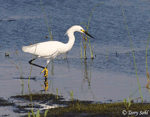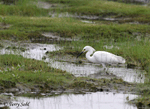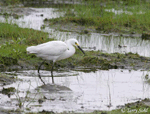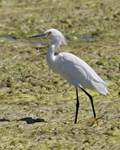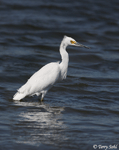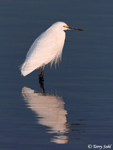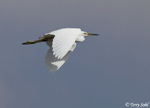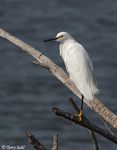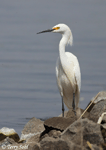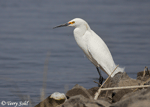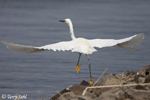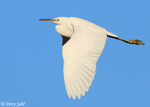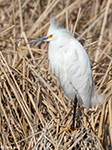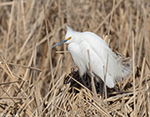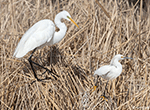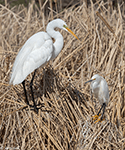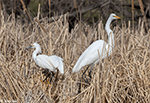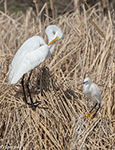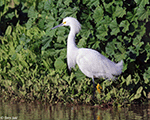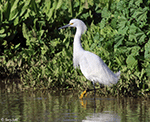| Length: 22 to 26 inches | Wingspan: 46 inches | Seasonality: Summer / Migrant |
| ID Keys: Black legs with contrasting yellow feet, black bill, all white plumage | ||
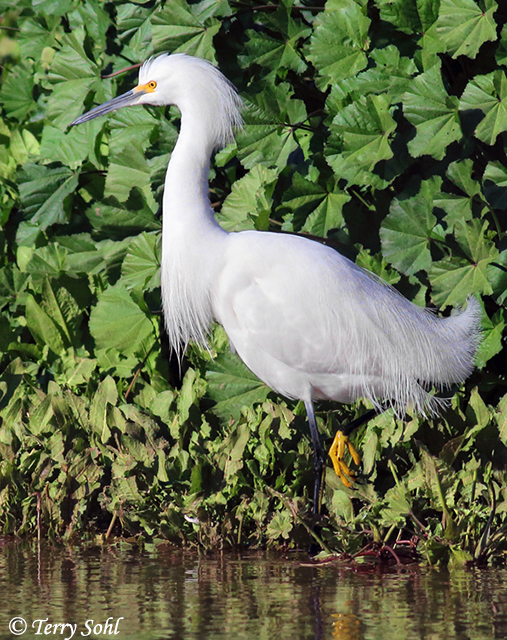 The elegant snowy egret
was killed by the thousands in the 1800's for its long, lacy breeding plumage,
which was used for women's hats and other clothing. It has recovered both
in range and numbers since that time. Of the white egrets found in South
Dakota, the Snowy Egret can be identified by its size (smaller than the Great
Egret), and it's yellow feet contrasting with black legs. See the Identification
Tips page for differentiating among the white Egrets and Herons in the
state.
The elegant snowy egret
was killed by the thousands in the 1800's for its long, lacy breeding plumage,
which was used for women's hats and other clothing. It has recovered both
in range and numbers since that time. Of the white egrets found in South
Dakota, the Snowy Egret can be identified by its size (smaller than the Great
Egret), and it's yellow feet contrasting with black legs. See the Identification
Tips page for differentiating among the white Egrets and Herons in the
state.
Habitat:
Prefers large sloughs or marshes, sometimes edges of ponds or lakes.
Diet:
Varies, but includes fish, crustaceans, insects, frogs, lizards, snakes, rodents, snails, and worms.
Behavior:
Uses a variety of foraging techniques. They will often actively wade through shallow waters, chasing prey that is startled by the movement. They will also stand still in shallow water, waiting for prey to approach. Snowy Egrets will also forage on dry land, usually in search of insects.
Nesting:
June and July. Breeds in colonies, typically mixed colonies with other wading bird species. The nest is a platform of sticks built in a tree or tall shrub. The female usually lays 3 or 4 eggs, and both parents help to incubate them. They have an unusual ritual when one bird takes over for another on the nest, sometimes passing a stick or other piece of vegetation between themselves when switching spots. When the eggs hatch, both parents help to feed the young. The young fledge after about 4 weeks.
Song:
Generally silent, except on their breeding grounds. There they have give some harsh and grating calls.
- Click here to hear the croaking call of a Snowy Egret at a nesting site1
- Click here to hear the harsh calls of a Snowy Egret taking flight2
Migration:
Birds in the interior of the country migrate to U.S. coastal areas, Mexico, and Central America in the fall.
Interactive eBird map:
Click here to access an interactive eBird map of Snowy Egret sightings
Similar Species:
Potentially confused with other white egret (and heron) species. See this page of identification tips for more detailed differences between species.
- Cattle Egret - Cattle Egrets are decidedly more "chunky" than a Snowy Egret, with a much shorter neck. Cattle Egrets have a yellowish bill and yellowish legs, compared to the black bill and black legs (with yellow feet) of a Snowy Egret.
- Great Egret - Great Egrets are considerably larger than Snowy Egrets (See Snowy Egret Photo Page for photos that show both species together). Great Egrets have black legs and feet, while Snowy Egrets have black legs and those distinctive yellow feet. The bill of a Great Egret is yellow, while it is black on a Snowy Egret.
- Little Blue Heron - Little Blue heron are but rare visitors to South Dakota, and as the name implies, they are blue (when they reach adult plumage). However, a juvenile Little Blue Heron has white plumage and could be confused with a Snowy Egret. Immature Little Blue Herons have yellowish-green legs, unlike the black legs (with yellow feet) on a Snowy Egret. The bill of an immature Little Blue Heron is two toned, with gray at the base and black at the tip. The bill of a Snowy Egret is completely black.
- Little Egret - Little Egrets are an Old World counterpart to the Snowy Egret that is a rare vagrant to North America. There was only once sighting in North America prior to 1980, but there have been an increasing number of sightings since then. They are the most similar to the Snowy Egret of any bird on this list. They can be differentiated by their slightly larger size, gray lores, and a long trailing head plume that is lacking on Snowy Egrets.
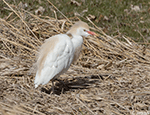 |
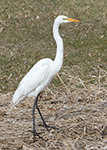 |
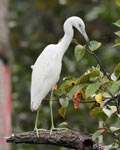 |
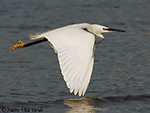 |
| Cattle Egret | Great Egret | Little Blue Heron (juvenile) | Little Egret |
Conservation Status:
Snowy Egreats are expanding range to the north and increasing population in recent decades. Despite recent populatiosn increases, overall numbers are still far below historical levels. However, populations are not in danger, and the IUCN lists the Snowy Egret as a species of "Least Concern".
Further Information:
Photo Information:
December 28th, 2018 - Gilbert Water Ranch in Phoenix, Arizona - Terry Sohl
Additional Photos:
Click on the image chips or text links below for additional, higher-resolution Snowy Egret photos.
Audio File Credits:
- 1Paul Marvin. Recorded in San Diego County, California on June 16th, 2019. Original recording and information from xeno-canto.
- 2Jayrson Araujo de Oliveira. Recorded in Chacara Jayrson, Brazil on September 23rd, 2018. Original recording and information from xeno-canto.
| Click on the map below for a higher-resolution view |
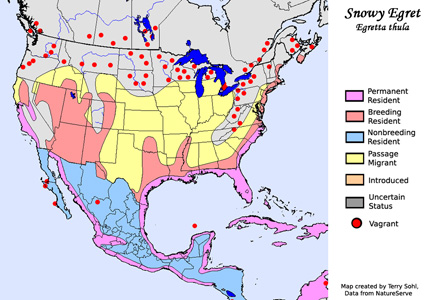 |
| South Dakota Status: Uncommon migrant in the eastern half of the state, rare in the west. Locally common summer resident in the northeast. |
Additional Snowy Egret Photos
Click for a higher-resolution version of these photos
